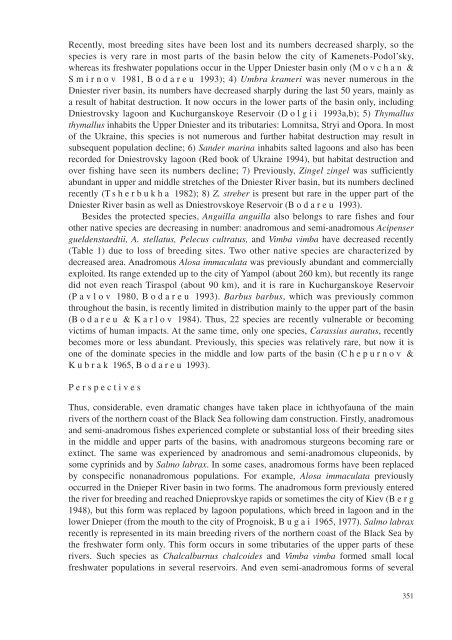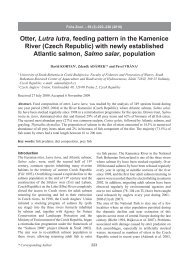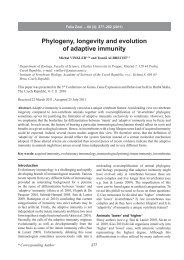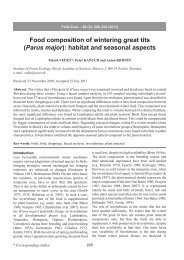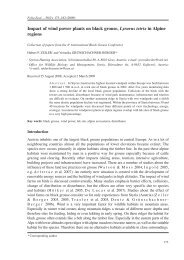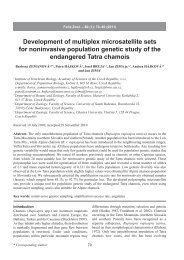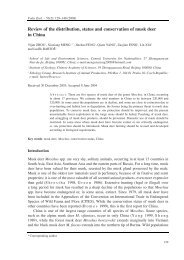alterations in ichthyofauna of the largest rivers
alterations in ichthyofauna of the largest rivers
alterations in ichthyofauna of the largest rivers
You also want an ePaper? Increase the reach of your titles
YUMPU automatically turns print PDFs into web optimized ePapers that Google loves.
Recently, most breed<strong>in</strong>g sites have been lost and its numbers decreased sharply, so <strong>the</strong><br />
species is very rare <strong>in</strong> most parts <strong>of</strong> <strong>the</strong> bas<strong>in</strong> below <strong>the</strong> city <strong>of</strong> Kamenets-Podol’sky,<br />
whereas its freshwater populations occur <strong>in</strong> <strong>the</strong> Upper Dniester bas<strong>in</strong> only (Movchan &<br />
Smirnov 1981, B odareu 1993); 4) Umbra krameri was never numerous <strong>in</strong> <strong>the</strong><br />
Dniester river bas<strong>in</strong>, its numbers have decreased sharply dur<strong>in</strong>g <strong>the</strong> last 50 years, ma<strong>in</strong>ly as<br />
a result <strong>of</strong> habitat destruction. It now occurs <strong>in</strong> <strong>the</strong> lower parts <strong>of</strong> <strong>the</strong> bas<strong>in</strong> only, <strong>in</strong>clud<strong>in</strong>g<br />
Dniestrovsky lagoon and Kuchurganskoye Reservoir (D o l g i i 1993a,b); 5) Thymallus<br />
thymallus <strong>in</strong>habits <strong>the</strong> Upper Dniester and its tributaries: Lomnitsa, Stryi and Opora. In most<br />
<strong>of</strong> <strong>the</strong> Ukra<strong>in</strong>e, this species is not numerous and fur<strong>the</strong>r habitat destruction may result <strong>in</strong><br />
subsequent population decl<strong>in</strong>e; 6) Sander mar<strong>in</strong>a <strong>in</strong>habits salted lagoons and also has been<br />
recorded for Dniestrovsky lagoon (Red book <strong>of</strong> Ukra<strong>in</strong>e 1994), but habitat destruction and<br />
over fish<strong>in</strong>g have seen its numbers decl<strong>in</strong>e; 7) Previously, Z<strong>in</strong>gel z<strong>in</strong>gel was sufficiently<br />
abundant <strong>in</strong> upper and middle stretches <strong>of</strong> <strong>the</strong> Dniester River bas<strong>in</strong>, but its numbers decl<strong>in</strong>ed<br />
recently (T sherbukha 1982); 8) Z. streber is present but rare <strong>in</strong> <strong>the</strong> upper part <strong>of</strong> <strong>the</strong><br />
Dniester River bas<strong>in</strong> as well as Dniestrovskoye Reservoir (Bodareu 1993).<br />
Besides <strong>the</strong> protected species, Anguilla anguilla also belongs to rare fishes and four<br />
o<strong>the</strong>r native species are decreas<strong>in</strong>g <strong>in</strong> number: anadromous and semi-anadromous Acipenser<br />
gueldenstaedtii, A. stellatus, Pelecus cultratus, and Vimba vimba have decreased recently<br />
(Table 1) due to loss <strong>of</strong> breed<strong>in</strong>g sites. Two o<strong>the</strong>r native species are characterized by<br />
decreased area. Anadromous Alosa immaculata was previously abundant and commercially<br />
exploited. Its range extended up to <strong>the</strong> city <strong>of</strong> Yampol (about 260 km), but recently its range<br />
did not even reach Tiraspol (about 90 km), and it is rare <strong>in</strong> Kuchurganskoye Reservoir<br />
(Pavlov 1980, B o d areu 1993). Barbus barbus, which was previously common<br />
throughout <strong>the</strong> bas<strong>in</strong>, is recently limited <strong>in</strong> distribution ma<strong>in</strong>ly to <strong>the</strong> upper part <strong>of</strong> <strong>the</strong> bas<strong>in</strong><br />
(Bodareu & Karlov 1984). Thus, 22 species are recently vulnerable or becom<strong>in</strong>g<br />
victims <strong>of</strong> human impacts. At <strong>the</strong> same time, only one species, Carassius auratus, recently<br />
becomes more or less abundant. Previously, this species was relatively rare, but now it is<br />
one <strong>of</strong> <strong>the</strong> dom<strong>in</strong>ate species <strong>in</strong> <strong>the</strong> middle and low parts <strong>of</strong> <strong>the</strong> bas<strong>in</strong> (Chepurnov &<br />
Kubrak 1965, Bodareu 1993).<br />
Perspectives<br />
Thus, considerable, even dramatic changes have taken place <strong>in</strong> <strong>ichthy<strong>of</strong>auna</strong> <strong>of</strong> <strong>the</strong> ma<strong>in</strong><br />
<strong>rivers</strong> <strong>of</strong> <strong>the</strong> nor<strong>the</strong>rn coast <strong>of</strong> <strong>the</strong> Black Sea follow<strong>in</strong>g dam construction. Firstly, anadromous<br />
and semi-anadromous fishes experienced complete or substantial loss <strong>of</strong> <strong>the</strong>ir breed<strong>in</strong>g sites<br />
<strong>in</strong> <strong>the</strong> middle and upper parts <strong>of</strong> <strong>the</strong> bas<strong>in</strong>s, with anadromous sturgeons becom<strong>in</strong>g rare or<br />
ext<strong>in</strong>ct. The same was experienced by anadromous and semi-anadromous clupeonids, by<br />
some cypr<strong>in</strong>ids and by Salmo labrax. In some cases, anadromous forms have been replaced<br />
by conspecific nonanadromous populations. For example, Alosa immaculata previously<br />
occurred <strong>in</strong> <strong>the</strong> Dnieper River bas<strong>in</strong> <strong>in</strong> two forms. The anadromous form previously entered<br />
<strong>the</strong> river for breed<strong>in</strong>g and reached Dnieprovskye rapids or sometimes <strong>the</strong> city <strong>of</strong> Kiev (B e r g<br />
1948), but this form was replaced by lagoon populations, which breed <strong>in</strong> lagoon and <strong>in</strong> <strong>the</strong><br />
lower Dnieper (from <strong>the</strong> mouth to <strong>the</strong> city <strong>of</strong> Prognoisk, Bugai 1965, 1977). Salmo labrax<br />
recently is represented <strong>in</strong> its ma<strong>in</strong> breed<strong>in</strong>g <strong>rivers</strong> <strong>of</strong> <strong>the</strong> nor<strong>the</strong>rn coast <strong>of</strong> <strong>the</strong> Black Sea by<br />
<strong>the</strong> freshwater form only. This form occurs <strong>in</strong> some tributaries <strong>of</strong> <strong>the</strong> upper parts <strong>of</strong> <strong>the</strong>se<br />
<strong>rivers</strong>. Such species as Chalcalburnus chalcoides and Vimba vimba formed small local<br />
freshwater populations <strong>in</strong> several reservoirs. And even semi-anadromous forms <strong>of</strong> several<br />
351


